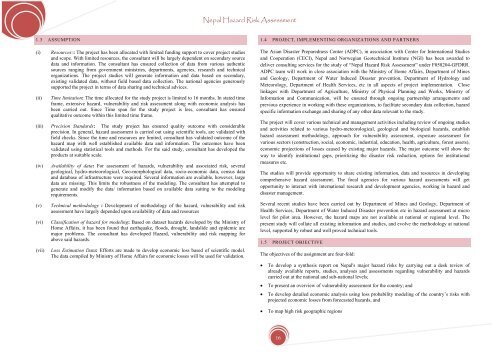Nepal Hazard Risk Assessment - Asia-Pacific Gateway for Disaster ...
Nepal Hazard Risk Assessment - Asia-Pacific Gateway for Disaster ...
Nepal Hazard Risk Assessment - Asia-Pacific Gateway for Disaster ...
You also want an ePaper? Increase the reach of your titles
YUMPU automatically turns print PDFs into web optimized ePapers that Google loves.
<strong>Nepal</strong> <strong>Hazard</strong> <strong>Risk</strong> <strong>Assessment</strong><br />
1.3 ASSUMPTION<br />
1.4 PROJECT, IMPLEMENTING ORGANIZATIONS AND PARTNERS<br />
(i)<br />
(ii)<br />
(iii)<br />
(iv)<br />
(v)<br />
(vi)<br />
(vii)<br />
Resources:: The project has been allocated with limited funding support to cover project studies<br />
and scope. With limited resources, the consultant will be largely dependent on secondary source<br />
data and in<strong>for</strong>mation. The consultant has ensured collection of data from various authentic<br />
sources ranging from government ministries, departments, agencies, research and technical<br />
organizations. The project studies will generate in<strong>for</strong>mation and data based on secondary,<br />
existing validated data, without field based data collection. The national agencies generously<br />
supported the project in terms of data sharing and technical advices.<br />
Time limitation: The time allocated <strong>for</strong> the study project is limited to 16 months. In stated time<br />
frame, extensive hazard, vulnerability and risk assessment along with economic analysis has<br />
been carried out. Since Time span <strong>for</strong> the study project is less, consultant has ensured<br />
qualitative outcome within this limited time frame.<br />
Precision Standards: The study project has ensured quality outcome with considerable<br />
precision. In general, hazard assessment is carried out using scientific tools, are validated with<br />
field checks. Since the time and resources are limited, consultant has validated outcome of the<br />
hazard map with well established available data and in<strong>for</strong>mation. The outcomes have been<br />
validated using statistical tools and methods. For the said study, consultant has developed the<br />
products at suitable scale.<br />
Availability of data: For assessment of hazards, vulnerability and associated risk, several<br />
geological, hydro-meteorological, Geo-morphological data, socio-economic data, census data<br />
and database of infrastructure were required. Several in<strong>for</strong>mation are available, however, large<br />
data are missing. This limits the robustness of the modeling. The consultant has attempted to<br />
generate and modify the data/ in<strong>for</strong>mation based on available data suiting to the modeling<br />
requirements.<br />
Technical methodology : Development of methodology of the hazard, vulnerability and risk<br />
assessment have largely depended upon availability of data and resources<br />
Classification of hazard <strong>for</strong> modeling: Based on dataset hazards developed by the Ministry of<br />
Home Affairs, it has been found that earthquake, floods, drought, landslide and epidemic are<br />
major problems. The consultant has developed <strong>Hazard</strong>, vulnerability and risk mapping <strong>for</strong><br />
above said hazards.<br />
Loss Estimation Data: Ef<strong>for</strong>ts are made to develop economic loss based of scientific model.<br />
The data compiled by Ministry of Home Affairs <strong>for</strong> economic losses will be used <strong>for</strong> validation.<br />
The <strong>Asia</strong>n <strong>Disaster</strong> Preparedness Center (ADPC), in association with Center <strong>for</strong> International Studies<br />
and Cooperation (CECI), <strong>Nepal</strong> and Norwegian Geotechnical Institute (NGI) has been awarded to<br />
deliver consulting services <strong>for</strong> the study of “<strong>Nepal</strong> <strong>Hazard</strong> <strong>Risk</strong> <strong>Assessment</strong>” under F058204-GFDRR.<br />
ADPC team will work in close association with the Ministry of Home Affairs, Department of Mines<br />
and Geology, Department of Water Induced <strong>Disaster</strong> prevention, Department of Hydrology and<br />
Meteorology, Department of Health Services, etc in all aspects of project implementation. Close<br />
linkages with Department of Agriculture, Ministry of Physical Planning and Works, Ministry of<br />
In<strong>for</strong>mation and Communication, will be ensured through ongoing partnership arrangements and<br />
previous experience in working with these organizations, to facilitate secondary data collection, hazard<br />
specific in<strong>for</strong>mation exchange and sharing of any other data relevant to the study.<br />
The project will cover various technical and management activities including review of ongoing studies<br />
and activities related to various hydro-meteorological, geological and biological hazards, establish<br />
hazard assessment methodology, approach <strong>for</strong> vulnerability assessment, exposure assessment <strong>for</strong><br />
various sectors (construction, social, economic, industrial, education, health, agriculture, <strong>for</strong>est assets),<br />
economic projections of losses caused by existing major hazards. The major outcome will show the<br />
way to identify institutional gaps, prioritizing the disaster risk reduction, options <strong>for</strong> institutional<br />
measures etc.<br />
The studies will provide opportunity to share existing in<strong>for</strong>mation, data and resources in developing<br />
comprehensive hazard assessment. The focal agencies <strong>for</strong> various hazard assessments will get<br />
opportunity to interact with international research and development agencies, working in hazard and<br />
disaster management.<br />
Several recent studies have been carried out by Department of Mines and Geology, Department of<br />
Health Services, Department of Water Induced <strong>Disaster</strong> prevention etc in hazard assessment at micro<br />
level <strong>for</strong> pilot area. However, the hazard maps are not available at national or regional level. The<br />
present study will collate all existing in<strong>for</strong>mation and studies, and evolve the methodology at national<br />
level, supported by robust and well proved technical tools.<br />
1.5 PROJECT OBJECTIVE<br />
The objectives of the assignment are four-fold:<br />
• To develop a synthesis report on <strong>Nepal</strong>'s major hazard risks by carrying out a desk review of<br />
already available reports, studies, analyses and assessments regarding vulnerability and hazards<br />
carried out at the national and sub-national levels;<br />
• To present an overview of vulnerability assessment <strong>for</strong> the country; and<br />
• To develop detailed economic analysis using loss probability modeling of the country’s risks with<br />
projected economic losses from <strong>for</strong>ecasted hazards, and<br />
• To map high risk geographic regions<br />
16
















